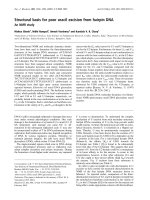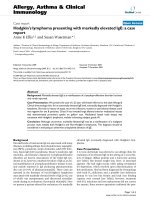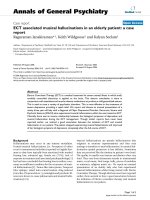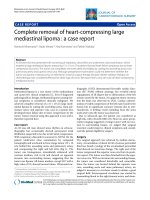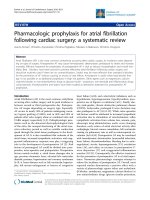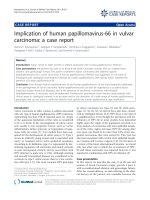Báo cáo y học: " Mid-term outcomes for Endoscopic versus Open Vein Harvest: a case control study" pptx
Bạn đang xem bản rút gọn của tài liệu. Xem và tải ngay bản đầy đủ của tài liệu tại đây (989.29 KB, 8 trang )
Kirmani et al. Journal of Cardiothoracic Surgery 2010, 5:44
/>Open Access
RESEARCH ARTICLE
BioMed Central
© 2010 Kirmani et al; licensee BioMed Central Ltd. This is an Open Access article distributed under the terms of the Creative Commons
Attribution License ( which permits unrestricted use, distribution, and reproduction in
any medium, provided the original work is properly cited.
Research article
Mid-term outcomes for Endoscopic versus Open
Vein Harvest: a case control study
Bilal H Kirmani
†
, James B Barnard
†
, Faisal Mourad
†
, Nadene Blakeman
†
, Karen Chetcuti
†
and Joseph Zacharias*
†
Abstract
Background: Saphenous vein remains the most common conduit for coronary artery bypass grafting with increasing
uptake of minimally invasive harvesting techniques. While Endoscopic Vein Harvest (EVH) has been demonstrated to
improve early morbidity compared to Open Vein Harvest (OVH), recent literature suggests that this may be at the
expense of graft patency at one year and survival at three years.
Methods: We undertook a retrospective single-centre, single-surgeon, case-control study of EVH (n = 89) and OVH (n
= 182). The primary endpoint was death with secondary endpoints including acute coronary syndrome,
revascularisation or other major adverse cardiac events. Freedom from angina, wound complications and self-rated
health status were also assessed. Where repeat angiography had been performed, this was reviewed.
Results: Both groups were well matched demographically and for peri-operative characteristics. All cause mortality
was 2/89 (2%) and 11/182 (6%) in the EVH and OVH groups respectively. This was shown by Cox Log-Rank analysis to
be non-significant (p = 0.65), even if adjusting for inpatient mortality (p = 0.74). There was no difference in the rates of
freedom from angina (p = 1.00), re-admission (p = 0.78) or need for further anti-anginals (p = 1.00). There was a
significant reduction in the incidence of leg wound infections and complications in the endoscopic group (EVH: 7%;
OVH: 28%; p = 0.0008) and the skew of high patient self-rated health scores in the EVH group (61% compared to 52% in
the open group) approached statistical significance (p = 0.06).
Conclusions: While aware of the limitations of this small retrospective study, we are heartened by the preliminary
results and consider our data to be justification for continuing to provide patients the opportunity to have minimally
invasive conduit harvest in our centre. More robust evidence is still required to elucidate the implications of
endoscopic techniques on conduit patency and patient outcome, but until the results of a large, prospective and
randomised trial are available, we believe we can confidently offer our patients the option and benefits of EVH.
Background
Coronary Artery Bypass Grafting (CABG) remains the
most common procedure in cardiothoracic surgery in the
United Kingdom [1] and saphenous vein is still the most
common conduit [2]. Traditional methods of vein har-
vest, in which a wound is opened along the length of the
long saphenous vein, often contribute significantly to
patient morbidity [3,4]. The advent of endoscopic vein
harvest (EVH) has allowed surgeons to minimise this and
many studies have demonstrated significantly reduced
pain, infection rates and hospital stays [5]. While saphen-
ous vein harvested endoscopically has been shown to
have histologically similar appearances compared to vein
harvested by the open method [6], preliminary studies
looking at endothelial changes at the cellular level have
given a mixed opinion [7,8]. Early studies showed statisti-
cally non-significant differences in graft patency at 6
months [9], and similar rates of event-free survival at 5
years [10]. The technique has not, however, been put
through a rigorous prospective randomised trial to dem-
onstrate its efficacy on long-term graft patency or patient
outcomes. This reflects the ethical and logistic dilemmas
of repeat angiography for large cohorts of asymptomatic
patients. Also absent from the literature is a large multi-
centre trial focussing on patient reported outcomes and
health related quality of life between the two groups.
* Correspondence:
1
Department of Cardiothoracic Surgery, Lancashire Cardiac Centre, Blackpool
Victoria Hospital, Whinney Heys Rd, Blackpool, Lancashire, UK
†
Contributed equally
Full list of author information is available at the end of the article
Kirmani et al. Journal of Cardiothoracic Surgery 2010, 5:44
/>Page 2 of 8
One recently published study suggests that endoscopi-
cally harvested vein may, in fact, be associated with
higher rates of vein-graft failure at one year and higher
rates of death, myocardial infarction and need for revas-
cularisation at three years [11]. One year graft patency
rates in the open vein harvest arm of this study were
equivalent to previous 20% graft failure rates demon-
strated elsewhere [12], but significantly higher in the
endoscopic group. In this subgroup analysis from a multi-
centre trial, however, the experience of the EVH operator
was variable, with many centres presumably in the
infancy of their endoscopic projects. The other weakness
was that the technique and equipment used were not
standardised and this may have impacted on the results of
the study.
Our aim was to examine local outcomes with EVH to
justify continued use of the technique in our centre and
to collate robust long-term follow-up data.
Methods
We undertook a retrospective case-control study of all
consecutive first-time isolated CABG using at least one
vein graft from a single surgeon in our centre. A study
group undergoing endoscopic vein harvest (EVH) and a
control group having open vein harvest (OVH) were con-
sidered. Inclusion criteria were bypass grafting of at least
two vessels by the consultant surgeon (JZ). Exclusion cri-
teria were: previous cardiac surgery; concomitant valve or
aortic surgery; use of radial arterial conduit; use of both
open and endoscopically harvested conduits; and routine
use of aprotinin.
Assuming the cited differences in graft patency [11]
manifesting as clinical symptoms, a power calculation
was performed, which calculated a sample size of 326 for
both groups with a 95% confidence interval and a statisti-
cal power of 75%.
Endoscopic vein harvest was performed with VASO-
VIEW 6 or VASOVIEW 7 Endoscopic Vessel Harvesting
Systems (Maquet Inc, Wayne, USA), using a carbon diox-
ide insufflation technique. 2,500 units of heparin were
administered prior to application of CO
2
. Diathermy was
employed to divide side branches in situ with titanium
clips applied prior to grafting. In the standard open tech-
nique, side branches were tied and clipped. Intermittent,
cold blood, antegrade cardioplegia was the predominant
method of myocardial protection.
The primary outcome measure was mortality, which
was determined by consulting the local civil registry for
deaths. Secondary outcome measures included any other
major adverse coronary event (MACE) including acute
coronary syndrome, or need for revascularisation. Free-
dom from angina was also used a secondary outcome
measure, for which patients were reviewed initially by
telephone survey to assess symptoms, readmissions and
use of new anti-anginals. Clinical history was used to
establish angina and dyspnoea grades on the Canadian
Cardiovascular Society (CCS) and New York Heart Asso-
ciation (NYHA) functional classifications. The patient
was also asked to score pain in the leg and sternal wounds
on a ten-point scale (0-none, 10-high) and their current
general health on a five-point scale of self-rated health
status (poor, fair, good, very good or excellent). They were
also asked to compare their health at the time of ques-
tioning with the pre-operative status on a five-point scale
(much worse, worse, the same, better, or much better).
Where patients cited clinical events or had required fur-
ther investigation or treatment, case-notes were reviewed
and, where relevant, angiographic data examined.
Numerical variables were compared by means of Stu-
dent's t-test for normally distributed data and Mann-
Whitney for non-parametric data. Categorical data was
compared by means of chi-squared or Fishers Exact tests.
Statistical analysis of data was performed using Prism 5
for Mac (GraphPad Inc, California, USA). Patients in
whom endoscopic vein harvest was intended but who
required conversion to an open procedure were included
in the open vein harvest group. Most conversions were
early in the experience and often due to difficulty in find-
ing the vein in the thigh. The quality of the vein would
not therefore have been affected by the conversion.
Results
Demographics
From the inclusion criteria, 455 eligible patients were
identified. 148 were excluded as they had been operated
on during a period of routine aprotinin use at the institu-
tion. A further 36 were excluded because of use of addi-
tional arterial conduits. Of the remaining 271 eligible
patients, 89 had undergone endoscopic vein harvesting
and 182 had undergone open vein harvesting (Figure 1).
The median length of follow-up in the open vein harvest
(OVH) group was 37 ± 6 months; and in the endoscopic
vein harvest (EVH) group was 17 ± 7 months.
The two groups were demographically well matched
although there was a significantly higher proportion of
hypercholesterolaemia in the open vein harvesting group.
In the endoscopic vein harvest group, there was a higher
proportion of left main stem disease and proportionally
fewer "good" left ventricular ejection fractions (Table 1).
Operatively, the patients had similar bypass and cross-
clamp times, although there were a smaller percentage of
elective procedures in the open vein harvest group.
Outcomes
Data for the primary outcome measure of death was
taken from the civil registry and therefore follow-up was
complete in all patients. All cause mortality in the endo-
scopic vein harvest group was 2/89 (2%) and in the open
Kirmani et al. Journal of Cardiothoracic Surgery 2010, 5:44
/>Page 3 of 8
vein harvest was 11/182 (6%). Log rank analysis from a
Kaplan-Meier survival estimation showed that there was
no statistically significant difference (p = 0.65) between
endoscopic and open vein harvest. Adjusting for early
mortality within thirty days (Figure 2) which was 0/89
and 4/182 in the EVH and OVH groups, respectively, did
not affect the statistical significance (p = 0.74). Cause of
death for both groups was predominantly non-cardiac
although four of the deaths in the open vein harvest
group were not accounted for by post-mortem (Table 2).
Clinical follow up was possible in 105 patients (58%) in
the open vein harvest group and 71 patients (80%) in the
endoscopic group. The remainder were lost to follow-up
at the point of telephone interview.
In both study groups, there was a statistically signifi-
cant reduction in angina and dyspnoea grades after
CABG as compared to pre-op (Table 3). Patients in the
endoscopic vein harvest group reported significantly
fewer problems with leg wounds, with less antibiotic
usage and district nurse involvement for delayed wound
healing (Table 4). Pain scores for both the leg and the
sternal wounds were not remarkably different between
the two groups although the difference was statistically
significant (p < 0.0001). There was no difference between
the two groups in requirements for new anti-anginals (p
= 1.00) or in the rates of re-admission with cardiac prob-
lems (7% in the EVH group and 9% in the OVH group) (p
= 0.78).
The average (mode and median) response in the self-
rated health-status was "very good" with 52% of patients
in the OVH group and 61% in the EVH describing their
general health as either very good or excellent. The differ-
ences in these distributions seemed to approach statisti-
cal significance (p = 0.06). Similarly, the average response
for the comparative health-status was "much better" with
81% in the OVH and 90% in the EVH groups stating that
they were "better" or "much better" symptomatically as
compared to before CABG.
Two patients in the EVH group and three in the OVH
group also reported having returned for repeat angiogra-
phy. In the EVH group, one patient had both of their
saphenous grafts patent; the other patient had a single
vein graft out of four occluded and the remainder patent.
Of the three patients in the OVH group, one patient had
all-patent grafts; one patient had an involuted LIMA but
patent saphenous vein grafts; and one had two occluded
saphenous vein grafts to the right coronary artery and the
first obtuse marginal (Table 5).
Discussion
Our unit has been performing endoscopic vein harvest
since 2007 in line with the current trend for minimally
invasive surgery. With the publication of the subgroup
analysis of the PREVENT IV Trial by Lopes et al, it was
felt necessary to scrutinise our local outcomes and mor-
tality in order to determine if we were doing our patients
a disservice. A retrospective analysis of the cohort that
had already undergone EVH was deemed to be the most
appropriate way of reviewing our results. We opted for a
case-control study from a single surgeon in order to min-
imise the number of confounding factors introduced by
different surgical techniques or management. While the
case and control cohorts were chronologically separated,
any benefits conferred by the contemporary nature of
endoscopic vein harvest were likely to be small as the
time period encompassed less than ten years [12]. In
addition, we aimed to minimise any significant changes
to practice that occurred during this time. For this rea-
son, we excluded 148 patients in whom aprotinin was
used as a routine protocol who would otherwise have
been included in the open vein harvest group. Although
there was a significantly higher proportion of non-elec-
tive patients in the open vein harvest group, pre-opera-
tive risk stratification using EuroSCORE was similar.
It was expected with a single-centre, single-surgeon
experience of newly adopted endoscopic vein harvest that
our sample size would fall short of statistical power, and
we acknowledge the need for a larger study population
and are in the process of contributing this data to a larger
registry. In addition, the loss of patients to follow-up may
have skewed results as those more willing or able to par-
ticipate in follow-up could be assumed to have a better
compliance with medical advice.
With these study limitations taken into consideration,
our results demonstrate a reassuring clinical outcome in
the medium term for endoscopic vein harvesting. We
have included all our cases from the very first as even
though there may be an acceptable learning curve in time
taken [13] we feel - with the current improvements in
Figure 1 Study profile. CABG = coronary artery bypass grafting. EVH
= endoscopic vein harvest. OVH = open vein harvest.
"""&4.//'
&4,1+'
&423' &4+2,'
$
$&423'
$
$&41+'
$
$&4+2,'
$
$&4+*/'
" &4+.2'
"&4-0'
&
&
23
'
&
#"&4+2' #"&411'
Kirmani et al. Journal of Cardiothoracic Surgery 2010, 5:44
/>Page 4 of 8
Table 1: Baseline characteristics of study groups
Characteristic Total
(n = 271)
Open Harvesting
(n = 182)
Endoscopic
Harvesting
(n = 89)
p value
Age - yrs 66.1 ± 9.6 67.5 ± 9.7 66.0 ± 9.6 0.93
Male - no. (%) 223 (82) 145 (80) 78 (88) 0.13
Body Mass Index 28 ± 4.5 28 ± 4.3 29 ± 4.9 0.12
Hypertension - no. (%) 207 (76) 139 (76) 68 (85) 0.56
Diabetes - no. (%) 0.31
No diabetes 208 (77) 144 (79) 64 (72)
Diet Controlled 9 (3) 4 (2) 5 (6)
Tablet Controlled 41 (15) 27 (15) 14 (16)
Insulin Dependent 13 (5) 7 (4) 6 (7)
Hypercholesterolaemia - no. (%) 235 (87) 168 (92) 67 (75) <0.001
Previous MI - no./total (%) 0.26
Last MI <30 days ago 27/140 (19) 22/97 (23) 5/43 (12)
Last MI 31 - 90 days ago 18/140 (13) 13/97 (13) 5/43 (12)
Last MI >90 days ago 95/140 (68) 62/97 (64) 33/43 (77)
Prior PCI - no. (%) 0.64
None 248 (92) 166 (91) 83 (93)
PCI >24 hrs prior to CABG 22 (8) 16 (9) 6 (7)
PCI <24 hrs prior to CABG 0 (0) 0 (0) 0 (0)
Previous stroke - no. (%) 23 (8) 16 (9) 7 (8) 1.00
Renal Failure - no. (%) 2 (1) 0 (0) 2 (2) 0.11
Peripheral Vascular Disease - no.
(%)
40 (15) 26 (14) 14 (16) 0.86
Pulmonary Disease - no. (%) 0.46
None 240 (89) 159 (87) 81 (91)
Asthma 16 (6) 13 (7) 3 (3)
COPD 15 (5) 10 (4) 5 (6)
Smoking - no. (%) 0.75
Never 91 (34) 60 (33) 31 (35)
Ex-smoker 145 (53) 100 (55) 45 (50)
Currently smoking 35 (13) 22 (12) 13 (15)
CCS grade - no. (%) 0.55
I 53 (20) 41 (23) 12 (13)
II 102 (38) 68 (37) 34 (38)
III 98 (36) 66 (36) 32 (36)
IV 27 (10) 20 (11) 7 (8)
NYHA grade - no. (%) 0.64
I 96 (35) 72 (40) 24 (27)
II 117 (43) 79 (43) 38 (43)
III 82 (30) 57 (31) 25 (28)
IV 11 (4) 7 (4) 4 (4)
LMS disease >50% - no. (%) 68 (25) 37 (20) 31 (35) 0.0165
Kirmani et al. Journal of Cardiothoracic Surgery 2010, 5:44
/>Page 5 of 8
technology, increasing adoption of minimally invasive
procedures and support from the industry - that it is
unacceptable to accept a reduction in conduit quality
during the learning curve.
Primary Outcomes
Our primary intention in undertaking this study was to
investigate the possibility of endoscopic vein harvest
adversely affecting survival and graft patency compared
to open vein harvest. Lopes et al made a valid criticism of
early studies, pointing out that many included patients in
follow up for 4 to 6 weeks after surgery whereas the diver-
gence in outcomes did not seem to manifest until one
year. Our results demonstrate no difference in mortality,
freedom from angina or major adverse cardiac events
between the two groups at a median follow up of 17
months. Similar results have recently been described by
Ouzounian, et al [14].
Freedom from angina is employed in this study as a sur-
rogate marker of graft patency, although it is known that
a significant proportion of asymptomatic patients may
have graft occlusion [15] and that recurrence of symp-
toms is not necessarily an indication of graft failure
[16,17]. It is not clear, however, what the clinical implica-
tions of asymptomatic graft failure are, as data from trials
in which angiography is incorporated into the study pro-
tocol may demonstrate twice as much graft failure as that
Left Ventricular Function - no. (%) 0.03
Poor <30% 10 (4) 7 (4) 3 (3)
Fair 31-49% 44 (16) 22 (12) 22 (25)
Good >50% 217 (80) 153 (84) 64 (72)
Number of distal grafts 3.4 ± 0.8 3.5 ± 0.8 3.3 ± 0.9 0.24
Parsonett Score 8.3 ± 6.6 8.6 ± 6.9 8.2 ± 6.4 0.67
EuroSCORE 3.4 ± 2.3 3.4 ± 2.5 3.2 ± 1.9 0.50
Bypass time - min 83.3 ± 23.9 81.9 ± 22.5 86.3 ± 26.5 0.15
Cross-clamp time - min 64.9 ± 18.8 64.0 ± 17.7 66.8 ± 20.9 0.24
Operative Priority - no. (%) 0.0014
Elective 232 (86) 146 (80) 86 (97)
Urgent 36 (13) 33 (18) 3 (3)
Emergency 3 (1) 3 (2) 0 (0)
Table 1: Baseline characteristics of study groups (Continued)
Figure 2 Kaplan Meier Curve showing all-cause out of hospital
mortality.
0 6 12 18 24
90
92
94
96
98
100
EVH
OVH
89 89 66 43 19
181 178 176 175 175
p=0.65
Drop off (months)
Percent survival
Number at risk
Table 2: All-cause mortality
OVH group
(n = 10) Cause of death
(time since op/months)
EVH group
(n = 2) Cause of death (time
since op/months)
1. Multi-organ failure
(inpatient)
1. Pancreatic carcinoma (15)
2. Aspiration pneumonia,
ileus (inpatient)
2. Hepatocellular
carcinoma (20)
3. Indeterminate (1)
4. Haemorrhage from aortic
cannulation site (1)
5. Cerebrovascular
accident (4)
6. Cerebral atrophy (16)
7. Indeterminate (8)
8. Indeterminate (12)
9. Prostate Carcinoma (25)
10. Multiple Myeloma (35)
11. Indeterminate (39)
Kirmani et al. Journal of Cardiothoracic Surgery 2010, 5:44
/>Page 6 of 8
seen in angiography for symptoms [18]. The management
of asymptomatic graft stenosis or occlusion remains con-
tentious as graft PCI and re-do CABG carry higher risk
burdens [19]. Conversely, progression of atherosclerosis
in saphenous grafts is associated with increased risk for
subsequent coronary events independent of symptoms
[20].
Gaining ethical approval to conduct protocol-driven
angiography for research purposes would be difficult in
the United Kingdom. The merits of subjecting asymp-
tomatic patients to a small but serious risk for the proce-
dure are questionable, especially where management may
not be altered. The use of non-invasive methods of
angiography in asymptomatic patients has been demon-
strated in the UK [15], but is probably not yet advanced
enough to replace traditional angiography [21].
Secondary Outcomes
Our study reiterates the significant improvement in
wound healing, complications and satisfaction after
endoscopic conduit harvest. While the differences in pain
scores were shown to be statistically significant (P <
0.0001) in favour of the traditional open technique, these
differences were likely to be beneath the sensitivity
threshold of the pain scale. The ten-point pain scale
probably requires a "minimal important change" of Δ2 in
order to be considered substantially different [22]. The
lack of any pain-related benefits in endoscopic versus
open harvest may also reflect the disparity in follow-up of
time since operation.
Self-rated health status is dependent on additional fac-
tors such as socio-economic status [23] and psychological
well-being [24], but has been shown to correlate well with
long-term survival after angioplasty [25]. In this popula-
tion, unmatched for psychosocial confounding factors,
the differences in our two study groups provides interest-
ing additional data, but we are cautious about interpret-
ing the implications any further than patient satisfaction.
Conclusions
Since its inception less than two decades ago, endoscopic
vein harvest has become both widely adopted and a com-
mon expectation from patients. The accepted wisdom of
minimal access conduit harvest has been called into ques-
tion lately due to the publication of a subgroup analysis
from the PREVENT IV Trial. Our review, despite its
potential flaws, was helpful for us to justify continuing
with our programme of EVH. We hope this will also reas-
sure other centres currently reviewing the practice while
Table 3: Angina and dyspnoea grading pre- and post-operatively
Characteristic Open Harvesting
(n = 105)
Endoscopic Harvesting
(n = 71)
CCS grade
Pre-op 2.1 ± 1.1 2.2 ± 1.0
Post-op 0.2 ± 0.6 0.2 ± 0.7 P = 0.95
P < 0.0001 P < 0.0001
NYHA grade
Pre-op 1.9 ± 0.8 2.1 ± 0.8
Post-op 0.5 ± 0.9 0.9 ± 0.9 P = 0.0013
P < 0.0001 P < 0.0001
Table 4: Post-operative complications and recurrences of symptoms
Characteristic Open Harvesting
(n = 105)
Endoscopic Harvesting
(n = 71)
P value
Leg wound infection - no. (%) 29 (28) 5 (7) 0.0008
Leg Wound pain 1.0 ± 2.3 1.3 ± 1.4 <0.0001
Sternal Wound pain 0.8 ± 0.9 1.6 ± 1.3 <0.0001
Need for new anti-anginals -
no. (%)
13 (12) 9 (13) 1.00
Further cardiac admissions -
no. (%)
9 (9) 5 (7) 0.78
Kirmani et al. Journal of Cardiothoracic Surgery 2010, 5:44
/>Page 7 of 8
we await the funding to carry out a long overdue prospec-
tive randomised trial looking specifically into the long
term effects of endoscopic vein harvesting.
Competing interests
The authors declare that they have no competing interests.
Authors' contributions
All authors were responsible for conceiving and developing the study proto-
col; JZ & NB performed all EVH cases; KC, FM, BHK & NB conducted telephone
interviews and collated data; BHK & JBB reviewed data and performed statisti-
cal calculations; BHK, JBB & JZ wrote the final manuscript. All authors read and
approved the final manuscript.
Acknowledgements
Many thanks to Cathy Malpas for her incalculable contribution to the collection
of data and to Sarah Draper for administrative efforts.
Author Details
Department of Cardiothoracic Surgery, Lancashire Cardiac Centre, Blackpool
Victoria Hospital, Whinney Heys Rd, Blackpool, Lancashire, UK
References
1. Survival Rates - Heart Surgery in United Kingdom [http://
heartsurgery.cqc.org.uk/Survival.aspx]
2. Allen K, Cheng D, Cohn W, Connolly M, Edgerton J, Falk V, Martin J,
Ohtsuka T, Vitali R: Endoscopic Vascular Harvest in Coronary Artery
Bypass Grafting Surgery: A Consensus Statement of the International
Society of Minimally Invasive Cardiothoracic Surgery (ISMICS) 2005.
Innovations: Technology and Techniques in Cardiothoracic and Vascular
Surgery 2005, 1(2):51-60.
3. Carpino PA, Khabbaz KR, Bojar RM, Rastegar H, Warner KG, Murphy RE,
Payne DD: Clinical benefits of endoscopic vein harvesting in patients
with risk factors for saphenectomy wound infections undergoing
coronary artery bypass grafting. J Thorac Cardiovasc Surg 2000,
119(1):69-75.
4. Reed JF: Leg wound infections following greater saphenous vein
harvesting: minimally invasive vein harvesting versus conventional
vein harvesting. Int J Low Extrem Wounds 2008, 7(4):210-219.
5. Markar SR, Kutty R, Edmonds L, Sadat U, Nair S: A meta-analysis of
minimally invasive versus traditional open vein harvest technique for
coronary artery bypass graft surgery. Interact Cardiovasc Thorac Surg
2009 [ />6. Kiaii B, Moon BC, Massel D, Langlois Y, Austin TW, Willoughby A,
Guiraudon C, Howard CR, Guo LR: A prospective randomized trial of
endoscopic versus conventional harvesting of the saphenous vein in
coronary artery bypass surgery. J Thorac Cardiovasc Surg 2002,
123(2):204-212.
7. Alrawi SJ, Raju R, Alshkaki G, Acinapura AJ, Cunningham JN: Saphenous
vein endothelial cell viability: a comparative study of endoscopic and
open saphenectomy for coronary artery bypass grafting. JSLS 2001,
5(1):37-45.
8. Rousou LJ, Taylor KB, Lu X, Healey N, Crittenden MD, Khuri SF, Thatte HS:
Saphenous vein conduits harvested by endoscopic technique exhibit
structural and functional damage. Ann Thorac Surg 2009, 87(1):62-70.
9. Yun KL, Wu Y, Aharonian V, Mansukhani P, Pfeffer TA, Sintek CF, Kochamba
GS, Grunkemeier G, Khonsari S: Randomized trial of endoscopic versus
open vein harvest for coronary artery bypass grafting: six-month
patency rates. J Thorac Cardiovasc Surg 2005, 129(3):496-503.
10. Allen KB, Heimansohn DA, Robison RJ, Schier JJ, Griffith GL, Fitzgerald EB:
Influence of endoscopic versus traditional saphenectomy on event-
Received: 30 March 2010 Accepted: 28 May 2010
Published: 28 May 2010
This article is available fro m: http://www. cardiothoracics urgery.org/con tent/5/1/44© 2010 Kirmani et al; licensee BioMed Central Ltd. This is an Open Access article distributed under the terms of the Creative Commons Attribution License ( ), which permits unrestricted use, distribution, and reproduction in any medium, provided the original work is properly cited.Journal of Cardiothoracic Surgery 2010, 5:44
Table 5: Angiographic findings in symptomatic patients
OVH group
(n = 3)
EVH group
(n = 2)
Patient One Patient One
LIMA - LAD Patent LIMA - LAD Patent
SVG - OM1 Patent SVG - OM2 Patent
SVG - RCA Patent SVG - RCA Patent
Patient Two Patient Two
LIMA - Diag (sequential) } LIMA involuted LIMA - LAD Patent
LIMA - LAD } and stented SVG - Diag Patent
RIMA - RCA Patent SVG - OM1 Patent
SVG - OM1 Patent SVG - OM2 Occluded
SVG - RCA Patent
Patient Three
LIMA - LAD Patent
SVG - OM1 Occluded
SVG - OM2 Patent
SVG - RCA Occluded
LIMA - Left Internal Mammary Artery, LAD - Left Anterior Descending Coronary Artery, SVG - saphenous vein graft, OMx - x
th
Obtuse Marginal,
RCA - Right Coronary Artery, Diag - Diagonal
Kirmani et al. Journal of Cardiothoracic Surgery 2010, 5:44
/>Page 8 of 8
free survival: five-year follow-up of a prospective randomized trial.
Heart Surg Forum 2003, 6(6):E143-145.
11. Lopes RD, Hafley GE, Allen KB, Ferguson TB, Peterson ED, Harrington RA,
Mehta RH, Gibson CM, Mack MJ, Kouchoukos NT, Califf RM, Alexander JH:
Endoscopic versus open vein-graft harvesting in coronary-artery
bypass surgery. N Engl J Med 2009, 361(3):235-244.
12. Shah P, Gordon I, Fuller J, Seevanayagam S, Rosalion A, Tatoulis J, Raman J,
Buxton B: Factors affecting saphenous vein graft patency: clinical and
angiographic study in 1402 symptomatic patients operated on
between 1977 and 1999. Journal of Thoracic and Cardiovascular Surgery
2003, 126(6):1972-1977.
13. Waqar-Uddin Z, Purohit M, Blakeman N, Zacharias J: A prospective audit
of endoscopic vein harvesting for coronary artery bypass surgery. Ann
R Coll Surg Engl 2009, 91(5):426-429.
14. Ouzounian M, Hassan A, Buth KJ, MacPherson C, Ali IM, Hirsch GM, Ali IS:
Impact of Endoscopic Versus Open Saphenous Vein Harvest
Techniques on Outcomes After Coronary Artery Bypass Grafting. The
Annals of Thoracic Surgery 2010, 89(2):403-408.
15. Campbell PG, Teo KSL, Worthley SG, Kearney MT, Tarique A, Natarajan A,
Zaman AG: Non-invasive assessment of saphenous vein graft patency
in asymptomatic patients. Br J Radiol 2009, 82(976):291-295.
16. Gansera B, Schmidtler F, Angelis I, Kiask T, Kemkes BM, Botzenhardt F:
Patency of internal thoracic artery compared to vein grafts -
postoperative angiographic findings in 1189 symptomatic patients in
12 years. Thorac Cardiovasc Surg 2007, 55(7):412-417.
17. Gansera B, Schiller M, Kiask T, Angelis L, Neumaier-Prauser P, Kemkes BM:
Internal thoracic artery vs. vein grafts postoperative angiographic
findings in symptomatic patients after 1000 days. Thorac Cardiovasc
Surg 2003, 51(5):239-243.
18. Buxton BF, Durairaj M, Hare DL, Gordon I, Moten S, Orford V,
Seevanayagam S: Do angiographic results from symptom-directed
studies reflect true graft patency? Ann Thorac Surg 2005, 80(3):896-900.
discussion 900-901
19. Virani SS, Alam M, Mendoza CE, Arora H, Ferreira AC, de Marchena E:
Clinical significance, angiographic characteristics, and short-term
outcomes in 30 patients with early coronary artery graft failure. Neth
Heart J 2009, 17(1):13-17.
20. Knatterud GL, White C, Geller NL, Campeau L, Forman SA, Domanski M,
Forrester JS, Gobel FL, Herd JA, Hickey A, Hoogwerf BJ, Hunninghake DB,
Terrin ML, Rosenberg Y: Angiographic changes in saphenous vein grafts
are predictors of clinical outcomes. Am Heart J 2003, 145(2):262-269.
21. Anders K, Baum U, Schmid M, Ropers D, Schmid A, Pohle K, Daniel WG,
Bautz W, Achenbach S: Coronary artery bypass graft (CABG) patency:
assessment with high-resolution submillimeter 16-slice multidetector-
row computed tomography (MDCT) versus coronary angiography. Eur
J Radiol 2006, 57(3):336-344.
22. Ostelo RWJG, Deyo RA, Stratford P, Waddell G, Croft P, Von Korff M, Bouter
LM, de Vet HC: Interpreting change scores for pain and functional
status in low back pain: towards international consensus regarding
minimal important change. Spine 2008, 33(1):90-94.
23. Dowd JB, Zajacova A: Does the predictive power of self-rated health for
subsequent mortality risk vary by socioeconomic status in the US? Int J
Epidemiol 2007, 36(6):1214-1221.
24. Mikolajczyk RT, Brzoska P, Maier C, Ottova V, Meier S, Dudziak U, Ilieva S, El
Ansari W: Factors associated with self-rated health status in university
students: a cross-sectional study in three European countries. BMC
Public Health 2008, 8:215.
25. Schroeder S, Baumbach A, Herdeg C, Oberhoff M, Buchholz O, Kuettner A,
Hanke H, Karsch KR: Self-rated health and clinical status after PTCA:
results of a 4-year follow-up in 500 patients. Eur J Intern Med 2001,
12(2):101-106.
doi: 10.1186/1749-8090-5-44
Cite this article as: Kirmani et al., Mid-term outcomes for Endoscopic versus
Open Vein Harvest: a case control study Journal of Cardiothoracic Surgery
2010, 5:44
